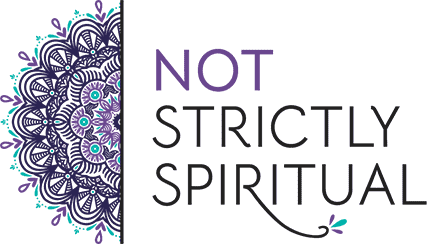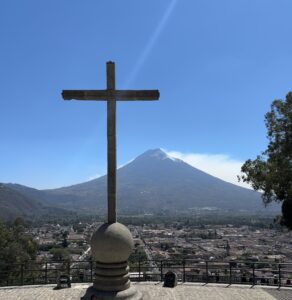
by Mary | Jul 29, 2011 | Food, Foodie Friday
If you’ve been reading Not Strictly Spiritual with any regularity, you know when I veer off the spiritual posting path, it’s often to talk about food — food I’m making, food I’m eating, food I’m craving. You get the idea.
So, today I’m launching my new weekly food-focused post: Foodie Friday. (more…)
by Mary | Jul 27, 2011 | Uncategorized
This is so much better than the version we do at church. Chiara was smiling from ear to ear when I put this on. H/T to The Ironic Catholic for this silly but satisfying version of Ode.
by Mary | Jul 25, 2011 | Books
 I have Joyce Rupp’s book Open the Door: A Journey to the True Self sitting on my desk next to a blank journal, just waiting for me to dive in. It was recommended to me by one of my dear spiritual mentors, but I’ve been hesitant to start, perhaps afraid of what I might discover about myself if I work through this book, or what I might feel called to do? I just chalk it up to the usual “I don’t have enough time” excuse, but I know it’s deeper than that.
I have Joyce Rupp’s book Open the Door: A Journey to the True Self sitting on my desk next to a blank journal, just waiting for me to dive in. It was recommended to me by one of my dear spiritual mentors, but I’ve been hesitant to start, perhaps afraid of what I might discover about myself if I work through this book, or what I might feel called to do? I just chalk it up to the usual “I don’t have enough time” excuse, but I know it’s deeper than that.
Now, having read this great interview with Joyce by Mike Leach of Why Stay Catholic, I’m inspired to begin my journey through Joyce’s “Door.” He asks her 21 questions about her faith journey, her work and her hope for the Church and the world. What a great way to get to know someone. Here’s the first few questions and answers to start you off, with a link to Mike’s page for the rest:
1. Joyce, how are you an average Catholic?
I was certainly an average Catholic back in the 1950’s, when I was living on a farm in northwest Iowa. One of eight children, baptized in a small rural Catholic church, I attended a parochial elementary and high school. Today I live with more questions than answers when it comes to Catholicism. Perhaps that still makes me an average Catholic.
2. What is your favorite word?
Hope
3. What is your least favorite word?
I don’t have a least favorite. I find words intriguing.
4. What sound or noise do you love?
Listening to softly falling rain on foliage
5. What sound or noise do you hate?
Motorcycles coming down my street in the middle of the night
6. What is your favorite book?
The Gitanjali by Rabindranath Tagore
7. Do you have a particular Catholic role model?
Caryll Houselander…
Click HERE to read the rest at Why Stay Catholic.
by Mary | Jul 23, 2011 | Books
The latest issue of The Evangelist, the Diocese of Albany’s weekly newspaper, included a story on local Catholic bloggers, and I was on the list.
Here’s a snippet from the story by Angela Cave:
Among the thousands of Catholic bloggers populating the Internet with thoughts on spirituality, politics and the Church are several well-known residents of the Albany Diocese.
Mary DeTurris Poust is the author of several books on spirituality and a column that appears in two newspapers. A parishioner of St. Thomas the Apostle Church in Delmar, she writes a personal blog called “Not Strictly Spiritual” (http://notstrictlyspiritual.blogspot.com) in addition to contributing regularly to Our Sunday Visitor newspaper’s daily blog(http://osvdailytake.com).
As many as 2,000 people read her posts at Our Sunday Visitor; about 100 follow Not Strictly Spiritual.
“Sometimes, it’s the oddest thing that will catch somebody’s attention,” said Mrs. DeTurris Poust, offering the examples of posts on a religion-themed episode of the “Glee” TV show and on an artsy statue of Blessed Pope John Paul II.
The blogger gets the biggest response when she exposes her vulnerability and helps readers on their own spiritual journeys.
Common topics include hindrances to her spiritual life, reflections on retreats and Bible readings, thoughts about liturgical seasons and an annual post about her miscarriage.
“People want that connection to other people when they’re hurting or going through a rough time,” she said. “I think that’s when my blog is at its best.”
On the other hand, “if you want a pesto recipe, I’ll give you that,” she added.
Some of her posts chronicle the lives of her husband and three children in words and photos, while others dissect the spiritual aspects of ordinary tasks.
One of Mrs. DeTurris Poust’s favorite blog entries explored her quest to survive the chore of doing laundry with a smile on her face, in a show of love for her family.
Yet another sought to find serenity in a bowl of oatmeal: “I want to become more aware of the connection between the fast-paced, non-thinking eating that I do and the fast-paced, non-thinking living that I do — and the praying that I don’t do,” she wrote.
But when she’s not in a “good spiritual place,” she’s honest about it with her readers.
“I certainly don’t want people to get the impression that I’ve got it all figured out,” she told The Evangelist. “I think we forget that, a lot of times — that we’re all out there, we’re all trying to walk this path and we can feel like we’re alone.”
You can read the full story, which includes links to other Capital Region bloggers, by clicking HERE. If you’re curious about some of the Not Strictly Spiritual posts Angela mentions in her story, here are a few links (just click on the title):
Learning to Let Go, Starting with the Laundry
Finding Serenity in a Bowl of Oatmeal
Remembering the Power of One Small Life
Where Am I? Connecting the Spiritual Dots
Angela also mentioned my blogging at OSV Daily Take, which you can find by clicking HERE.
by Mary | Jul 22, 2011 | Uncategorized
She was one of Jesus’ closest disciples, there at the foot of the cross when the others ran away, the first one Jesus appeared to after the Resurrection, a critical figure in the earliest Church, the “Apostle to the Apostles,” and yet Mary Magdalene continues to be dogged by the incorrect identification as the prostitute from Scripture, or, when novelist Dan Brown gets involved, as the wife of Jesus.
So today, on the Feast of Mary Magdalene, I was so happy to read “Who Was Mary Magdala?” by Jesuit Father James Martin over on America’s In All Things blog.
Father Martin writes:
The most benign explanation for this confusion over Mary’s identity is that there is a veritable crowd of Marys in the Gospel stories (besides Mary, the mother of Jesus, there is Mary of Bethany and Mary, the wife of Clopas). Mary Magdalene was also, oddly, conflated with a woman who had bathed Jesus’ feet with her tears, dried them with her hair, and then anointed them with oil. In AD 591, Pope Gregory I preached a sermon in which he proclaimed, “She whom Luke calls the sinful woman, whom John calls Mary, we believe to be the Mary from whom seven devils were ejected according to Mark.”
This inaccurate identification became more or less church teaching for at least a millennium.
A less benign interpretation of this “confusion” is that the early church was threatened, even horrified, by the stunning example of a woman among the early disciples. Strictly based on the evidence in the Gospels, Mary Magdalene enjoyed an exalted standing. She was not only the first one to whom Jesus appeared after the Resurrection, but also the one who proclaimed the news of his resurrection to the other disciples, including those who would be the leaders of the early church communities: Peter, James, Andrew, and the rest.
Thus comes Mary’s traditional title: “Apostle to the Apostles.” Her fidelity to Jesus during the Crucifixion, as well as Jesus’ appearance to her, are marks of distinction that place her, at least in terms of her faith, above the men. Some of the “extracanonical,” or “apocryphal,” gospels (that is, those not included by the early church councils with the traditional four Gospels) picture her as the most favored of all the disciples. “[Christ loved] her more than all the disciples,” says the text known as The Gospel of Philip.
Perhaps it was convenient for the early church fathers to dismiss Mary Magdalene and even insult her as a prostitute, fearful of what her role would mean for the place of women in the early church.
They didn’t teach that version in CCD class, did they? Can I get an Amen? Now, please go read the rest of the post — which is an excerpt from Father Martin’s A Jesuit Off-Broadway: Behind the Scenes with Faith, Doubt, Forgiveness and More — by clicking HERE. You’ll get to read Father Martin’s take on the “marginalization of Mary Magdalene” in its newest form, thanks to Dan Brown’s Da Vinci Code, which is too often taken as fact, even by well-meaning Catholics.
St. Mary Magdalene, pray for us.





